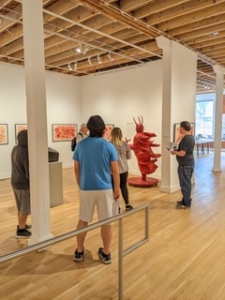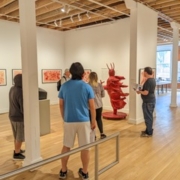How Art Can Harness the Healing Power Within Us
 “Art can harness the healing power within each of us and help bring us into community with one another,” wrote educator Jackie Armstrong in the magazine of the Museum of Modern Art (MoMA) in New York City. “When in front of an artwork, we are connected to the artist and to others who have experienced it. And connection, to ourselves and others, is at the core of art and healing. Healing isn’t a destination with a fixed timeline or endpoint but rather a path—or many paths. Just like each visit with a favorite work of art is a new experience with new insights, healing is a journey with possibilities stretching out in all directions.”
“Art can harness the healing power within each of us and help bring us into community with one another,” wrote educator Jackie Armstrong in the magazine of the Museum of Modern Art (MoMA) in New York City. “When in front of an artwork, we are connected to the artist and to others who have experienced it. And connection, to ourselves and others, is at the core of art and healing. Healing isn’t a destination with a fixed timeline or endpoint but rather a path—or many paths. Just like each visit with a favorite work of art is a new experience with new insights, healing is a journey with possibilities stretching out in all directions.”
Art is also part of the healing process facilitated by the treatment team at Colorado Recovery. After initially working in transitional housing at Colorado Recovery, Peter Kamback, MFA, had the opportunity to lead an art group before taking on his current role as a vocational rehabilitation specialist. He feels art is too often sidelined in our society and delights in allowing mental health patients to express themselves through art. Kamback likes to incorporate his art background in his current role and build on his experience with groups.
Colorado Recovery’s approach to treatment is about nurturing an environment of inclusivity, socialization, and community building. Clients are encouraged to take part in activities out in the community and within our own community as well.
A recent trip to the Boulder Museum of Contemporary Art is a good example. “It’s a great opportunity to see clients in a more natural setting and get a better sense of them as persons rather than patients,” said Kamback. “You experience them as people in a public location and also note how they interact with each other.”
BMoCA in downtown Boulder is easily accessible for Colorado Recovery patients. “It’s a small building but they utilize the space well,” Kamback remembered. “They featured three different artists that none of us—myself included—were familiar with. It was good to come in fresh and let clients explore the space. The museum wasn’t too busy so they were really comfortable with that. On this particular excursion, I specifically encouraged them to wander around and look at all the art on display, and then choose a favorite.”
After they got back to the campus, they got together and discussed the artwork they had viewed and which one they liked the best. “We had a sort of debriefing: ‘What drew you to this particular piece?’ and then others could chime in and we talked about feelings and emotions—what it was like to be at the museum.”
Because of his art background, Kamback excels at organizing and processing this kind of outing. He knows where to draw the line and not exhaust clients too much and make them lose interest. “We had a good time on this trip. This was a great opportunity for them to be in a public space. We used public transport to get there and they had good interactions the whole way. The whole trip is the experience, not just the museum visit.”
Trips to the art museum, hikes, game and movie nights, and other socializing activities are all part of the groundbreaking approach to mental health treatment pioneered by Colorado Recovery founder Richard Warner.
Recovery from serious mental illness requires that people with such a condition retain a sense of empowerment—a belief in their ability to take charge of their lives and manage the complex challenges of their illness.
At Colorado Recovery it is our mission to help adults with serious mental health issues stabilize their illness, minimize symptoms, improve functioning, and enhance each person’s social inclusion, quality of life, and sense of meaning in life.
If you have questions about our recovery model or our services to treat schizophrenia, bipolar disorder, and similar mental illnesses, call us at 720-218-4068 to discuss treatment options for you or the person you would like to help.





